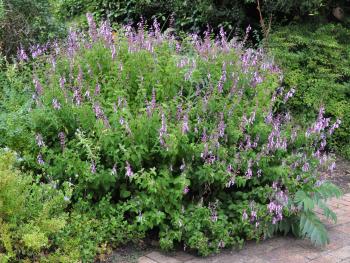Ocimum labiatum
Ocimum labiatum (N.E.Br.) A.J.Paton
Family: Lamiaceae
Common names: pink sage bush, shell bush (Eng.); pienksalie (Afr.)
Introduction
A stunning drought-hardy ornamental shrub which thrives in full sun or partial shade, flowering prolifically from early summer to late autumn.

Description
Description
The pink sage is a fast-growing, many branched, semi-deciduous shrub with aromatic heart-shaped leaves. It grows to a height and spread of 1.5m.

Distribution and habitat
Distribution description
It occurs on rocky hillsides with a scattered distribution through KwaZulu-Natal, Swaziland, into the northern provinces of South Africa and further into Zimbabwe.
Derivation of name and historical aspects
History
This plant was previously known as Orthosiphon labiatus. The specific epithet labiatum, meaning lipped, is a reference to the prominent lips of the flower.
Ocimum labiatum belongs to the very large, internationally distributed sage family, the Lamiaceae, widely cultivated for its herbal properties. This family includes many important herbs such as mint, rosemary and sage.
Uses
Use
It is useful for mass planting in large areas such as parks or large flower beds as it makes a wonderful display when used in this manner. For the smaller garden it can be planted in small groups or individually as part of a mixed backdrop or as a shrubby border under trees. The pink sage is also useful for attracting butterflies to the garden.
Growing Ocimum labiatum
Grow
Ocimum labiatum is a very popular garden plant as it is hardy to a moderate degree of frost and extreme drought, once established. It is prized for its showy display of pink-mauve, sage-like flowers which are carried on the shrub for a large part of the year, mainly through the summer months. It should be planted in full sun for best flowering, but will grow equally well in semi-shade. Although it is drought hardy and will grow under extreme conditions, it thrives when planted in rich, deep, composted garden soil and kept well watered.
The plant may be cut back to one-third of its height every couple of years to rejuvenate the woody growth. This should be done before the onset of its summer growing season and followed by a thick dressing of compost which can either be worked into the soil around the bush or left as a thick organic mulch. This is also a good time to apply a balanced fertilizer followed by a good deep soaking of water.
The plant can easily be propagated from seed or cuttings. However, the seedlings are so fast-growing that propagation from cuttings is rarely necessary. Sow seed in spring in fine potting mix and cover very lightly. Keep the trays in a semi-shaded position until they have germinated, which may take from two to four weeks. Transplant the seedlings into individual containers when they are large enough to handle.
References
- Arnold, T.H. & De Wet, B.C. (Eds) 1993. Plants of southern Africa: names and distribution. Memoirs of the botanical Survey of South Africa No 62.
- Joffe, P. 1993 The Gardeners Guide to South African Plants. Tafelberg Publishers Limited: Capetown.
- Joffe. P. 2001.Creative Gardening with Indigenous Plants, a South African guide. Briza Publications: Pretoria.
- Pooley. E 1993. The complete field guide to Trees of Natal, Zululand & Transkei. Natal FloraPublications Trust: Durban.
Credits
Andrew Hankey
Witwatersrand National Botanical Garden
December 2001
Plant Attributes:
Plant Type: Shrub
SA Distribution: KwaZulu-Natal, Limpopo, Mpumalanga, North West
Soil type: Loam
Flowering season: Late Summer, Autumn
PH: Acid, Neutral
Flower colour: Purple, Mauve/Lilac
Aspect: Full Sun, Morning Sun (Semi Shade)
Gardening skill: Easy
Special Features:
Horticultural zones









Rate this article
Article well written and informative
Rate this plant
Is this an interesting plant?
Login to add your Comment
Back to topNot registered yet? Click here to register.